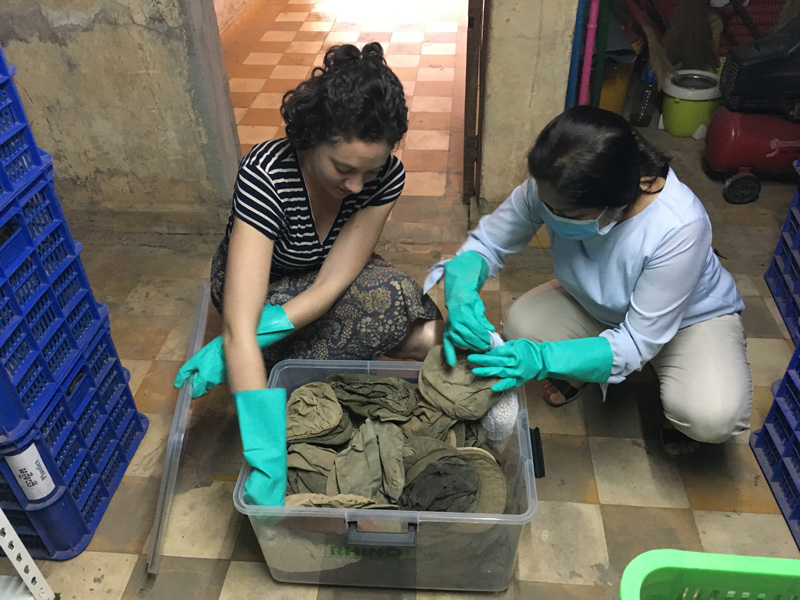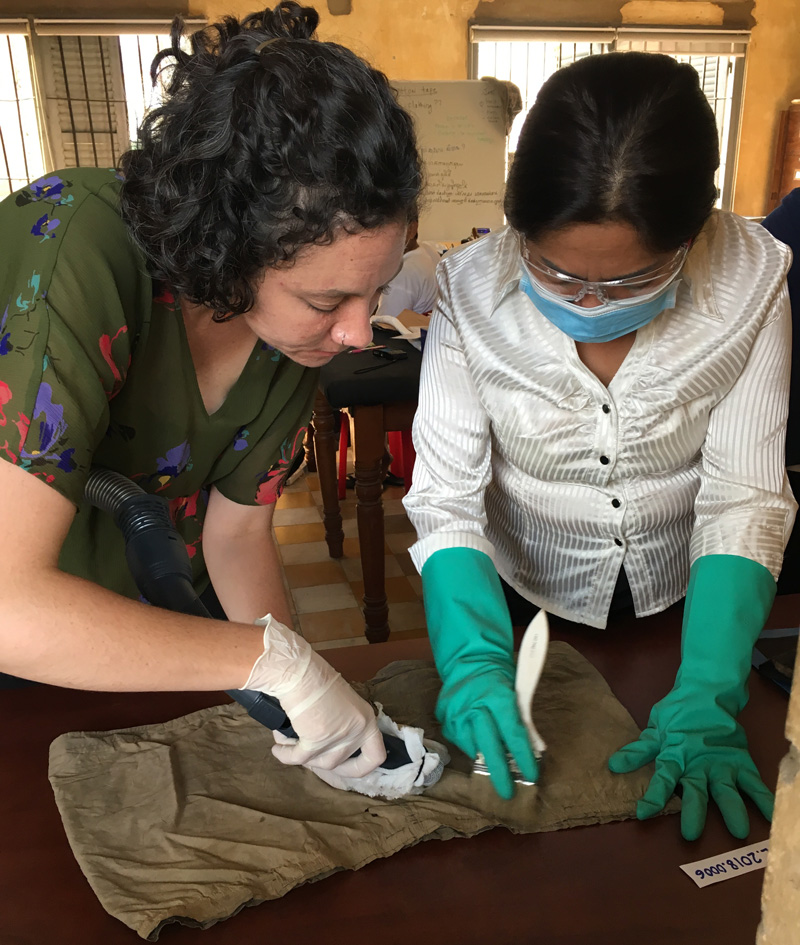


The garments of genocide
Photos courtesy of Julia Brennan February 19, 2018
UD grad student helps conserve clothing once worn by victims of Khmer Rouge torture
The shorts and shirts, shoes and socks, trousers and caps and whatever else they were wearing when they were brought to this torture center run by the Khmer Rouge in Cambodia have been lying in piles or packed into plastic bags for decades. Now a project funded by the United States Ambassador's Fund for Cultural Preservation is underway to conserve these garments so that future generations may remember the genocidal price paid by victims of the brutal regime, which was in power there from 1975 to 1979. During that period, more than 1.5 million people are believed to have been killed - many in an estimated 150 torture and execution centers and others by starvation and disease in forced labor camps.
University of Delaware graduate student Jackie Peterson of Syracuse, New York -- a National Endowment for the Humanities Fellow in the Winterthur/University of Delaware Program in Art Conservation -- recently spent two weeks in Phnom Penh working with textile conservation expert Julia Brennan, owner of Washington, D.C.-based Caring for Textiles, to set up an inventory protocol and initiated the first steps of preserving this clothing.
They worked at what was known as Security Prison 21 (S-21), a former high school that now hosts the Tuol Sleng Genocide Museum.
UDaily talked with Peterson last week, a few days before she left Cambodia. Parts of the interview have been edited for space and/or clarity.
UD: How did you get involved in this work?
JP: I first heard about the project through the University during my first year of school -- in 2015. Julia Brennan reached out to see if there was a student interested in textile conservation who was willing to work on this project. I saw it as a once-in-a-lifetime kind of thing. The funding fell through that year and again last year, but I got an email from her in early fall saying she had secured an ambassador's grant and was I in? Definitely! She has worked with textile collections around the world -- Thailand, Bhutan, elsewhere in Asia and just about everywhere you can imagine. She was in Rwanda recently working with the clothing of genocide victims and this model is a slight adaptation of what she had done there.
UD: Your work focuses on textile conservation, which often involves fine art and iconic treasures. This is a much different mission, isn't it?
JP: I think this is even more important. These are not objects that were historically cherished -- not like the fine arts at the Philadelphia Museum of Art or Hagley Museum. This is a completely different kind of textile. But the same principles of conservation apply for the most part. The fact that they haven't been cared for, have been in the tropics in a climate not amenable to keeping them for the long-term makes this work really important.
UD: How much do you know about the items you have identified for conservation?
JP: We're still trying to establish a chronology here -- that is a big question of ours. A lot of what we learn is oral history, someone here knew someone or heard something. S-21 was made into a memorial site and museum almost immediately after Phnom Penh was captured by the Vietnamese in 1979. They wanted to preserve the evidence and show what was there when they came in. There are black-and-white images of piles of clothing. We know it was here, a lot of it, and were told it was collected here. The clothing was put into piles because of the striking visual impact that has. Some of it now is in glass cases. The textiles we're working on were found in plastic bags when Julia first visited in 2015. They haven't been cleaned or touched. They are dirty and muddy, they have mildew and there was a really big termite problem. We can see evidence of insect activity.

UD: Who initiated this work?
JP: Julia was asked to come and do a consultation by someone who worked at Choeung Ek - the "Killing Fields" -- where clothing is often found as it surfaces from the unexhumed mass graves. She did a consultation there and the director of Tuol Sleng Genocide Museum -- Visoth Chhay -- met her there. He told Julia that they had this clothing at S-21 and asked what they should do with it.
UD: What have you learned about Tuol Sleng?
JP: People from all walks of life were detained and tortured here. High-profile prisoners, men, women and children -- even Khmer Rouge cadre accused of being traitors. There were prisons and torture centers like this all over Cambodia. But the amazing thing is -- Cambodia is beautiful. Phnom Penh is beautiful. The people are wonderful. It is really hard to believe that just 40 years ago this was going on.
UD: What sort of work have you been doing during this initial visit?
JP: We have been leading a workshop with several participants - two recent university graduates, a collections manager at Tuol Sleng, employees of the museum, a person who is in charge of the textile department at the National Museum of Cambodia, for example -- and talking about the basics of textile conservation, storage and handling, environmental monitoring, pest management -- almost everything you cover in the first year of the Winterthur at UD program, but here in just a couple of days.
UD: Could you tell us about some of the items in the collection?
JP: It is mostly clothing, but we have only begun going through the collection. There is a large number of caps, the green military style with a small band, and we have been going through a box of pants and shorts that almost all have elaborate patchwork repairs. Nothing was thrown away here, clothing was reused over and over again. We're not seeing many shirts. There are a lot of fragments of textiles that were collected, lots of small shoulder bags, military style for water bottles, ammunition and guns. Some have inscriptions or markings on them. As we look through those, the process of documentation will be really important so other researchers have access to the collection and can see what is there.
UD: What sort of inventory protocols do you observe?
JP: We have been teaching the basics of textile conservation -- how to look at objects, how to move objects, the importance of everything having an inventory number so that we know what we have. The paper inventory form has a place for the number and a series of boxes that get checked, a place for a written description of the object, notes about accretion, surface dirt, holes from insects. Every object will be photographed with a digital image record. We are trying to remove heavy accretions and nasty surface dirt, but that is pretty minimal. All of the dirt we remove is being saved. Basic information about each object is then entered into a digital database for easy searchability.
UD: Is it hard to decide how to treat these items?
JP: We made the definitive decision not to 'wet clean' anything because it would be too invasive. You never know what human data is present and that wouldn't be appropriate.
UD: Will all of the objects be salvageable?
JP: We're going to save everything whether or not it will serve a purpose in the future. You never know who will be interested in researching what. If may not be conservable by the Western definition -- what you might put on display at a fine art museum -- but it is conservable in a box long-term in a managed relative humidity situation. This collection hasn't been looked at at all, but the archives have been well-studied.
UD: Have you talked with - or will you talk with - family members of these prisoners?
JP: It was so recent -- 1979 was not that long ago -- and it comes up a couple times every day. The people we are working with -- everybody has a story about it. People my age or younger may be more removed, but really personal stories are coming out as we get to know the people we're working with.
UD: What impressed you as you entered the Tuol Sleng Genocide Museum for the first time?
JP: I had been trying to prepare myself for months. I was nervous about how I would handle it emotionally. But it is in the middle of the city. There is a boisterous neighborhood all around it, with cafes and shops. It's a residential area. But you walk through the gates -- it is a sizable complex -- and the buildings are kind of rundown. It is really quiet. You walk in and it's extremely peaceful, there are flowering trees in the courtyard and it's kind of lovely. Then you walk into the buildings - and it's just so hard to believe.
UD: Those buildings were where much of the suffering occurred. What is it like now?
JP: It's a huge tourist destination. Tour busses drop people off. It's kind of bizarre, but it's important to keep this memory alive. The audio tour gives a lot of information about the different locations and the compound and the survivor testimonies. It was difficult to go there for the first time. Then you go outside and there are benches all around the courtyard. Visitors sit and almost everyone has the same expression -- quiet contemplation.
UD: What will happen next with this project?
JP: We hope to come back in September for the second phase of the project. We will be here longer then, using a desiccant (drying agent) adopted from the agriculture industry. We put all of the garments into plastic boxes with gaskets -- airtight -- and use desiccant to reduce the relative humidity in each box and create a microclimate that should protect them from mold growth and hopefully limit insect activity.
UD: As you reflect on this - what are your thoughts now?
JP: It's such an honor to be part of this. It's one thing to work with fine art collections in fine art museums in the U.S. or Europe. This just feels a lot more necessary and a lot more important. This is an effort that needs our help. It is difficult and I'm tired. But to work with this collection is an honor and pretty inspiring.
Contact Us
Have a UDaily story idea?
Contact us at ocm@udel.edu
Members of the press
Contact us at 302-831-NEWS or visit the Media Relations website

